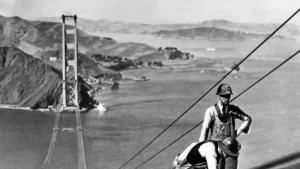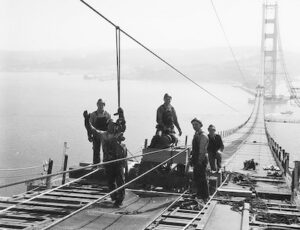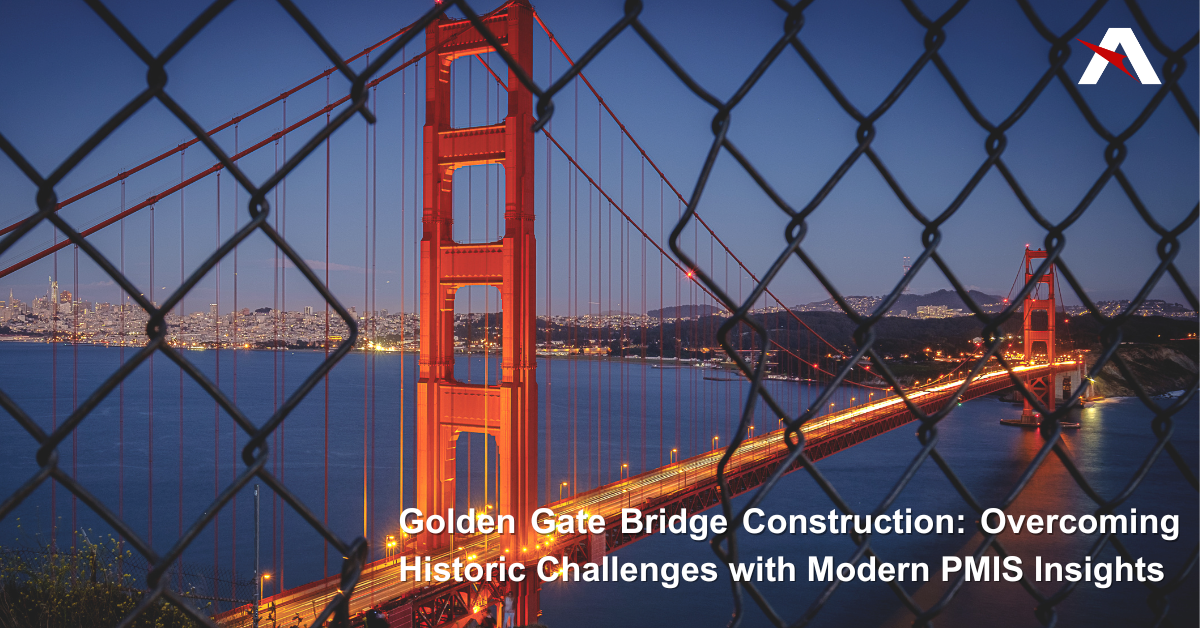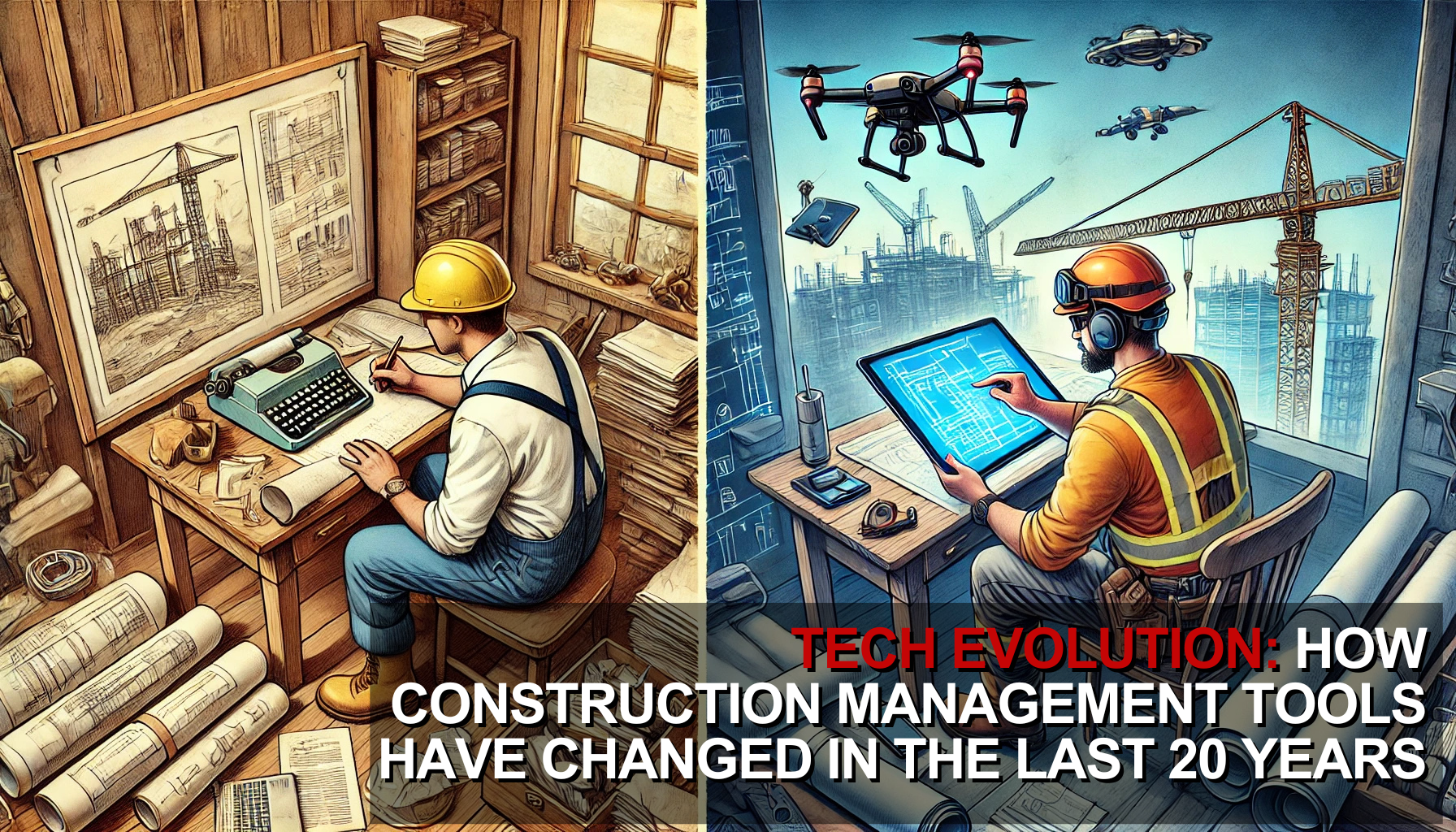The Golden Gate Bridge construction stands as one of the most iconic engineering feats in history, blending innovation with immense challenges. In this blog, we’ll dive into the construction journey, uncovering the dangers workers faced and the pioneering safety measures introduced, such as harnesses and leather hardhats. From navigating harsh weather to overcoming communication barriers, the story of the Golden Gate Bridge exemplifies human resilience and ingenuity.
But what if today’s technology had been available during its construction? Imagine how a modern Project Management Information System (PMIS) like ATSER’s Manage-IT™ could have streamlined planning, optimized workflows, and elevated safety standards. Join us as we reimagine the Golden Gate Bridge’s creation through the lens of today’s cutting-edge project management tools.
The Golden Gate Bridge History
The Golden Gate Bridge, located in San Francisco, California, was constructed under the primary leadership of Chief Engineer Joseph Strauss. Construction began in 1933 and was completed in 1937, making the Golden Gate Bridge the longest and tallest suspension bridge in the world at the time. It is celebrated as a triumph of engineering, overcoming challenges such as high winds, strong tides, and uneven seafloor.
Not only does the bridge now transport 40 million cars annually, but the iconic “International Orange” color also attracts millions of tourists to the San Francisco area each year, as many seek to enjoy the breathtaking views. It has also been featured in a wide variety of famous films, including Star Trek (1979) and Rise of the Planet of the Apes (2011). Overall, the Golden Gate Bridge embodies America’s strength and innovation, as it was constructed during the Great Depression using various techniques to combat the intense weather conditions.

Golden Gate Bridge Construction Facts
The Golden Gate Bridge has made significant contributions to California and modern pop culture. The construction process, which spanned four years, offers valuable lessons in project management. Here are some compelling facts about the bridge’s construction in 1933:
- Detailed records were not kept for most of the crew members who worked on the Golden Gate Bridge, aside from the ten main prime contractors.
- Eleven men tragically lost their lives during construction, while nineteen others were saved by a safety net installed beneath the bridge. Those who were saved became known as the “Halfway-to-Hell Club.”
- The innovative safety net cost $130,000 at the time and extended 10 feet wide on both sides of the bridge—a substantial investment in worker safety during the Great Depression.
- This project marked one of the first uses of hardhats, with safety lines strictly enforced. Workers who refused to wear them were dismissed.
- The total construction cost of the bridge was approximately $35 million.
- The Golden Gate Bridge was primarily built using 83,000 tons of steel, concrete, and 27,572 individual wires woven together to form the two main suspension cables.

Constructing the Golden Gate Bridge was an impressive yet perilous undertaking. The project required extensive planning and a dedicated team of workers, all of whom faced significant challenges throughout the process. Today, however, many of these obstacles could be mitigated or eliminated with modern project management technology.

Project Management Obstacles
While the Golden Gate Bridge stands strong today, achieving that engineering marvel was incredibly difficult. Here are the key project management challenges the large team came across:
1. Communication
When constructing the Golden Gate Bridge, real-time digital technology didn’t exist. Wired telephones were limited by their lack of portability, and two-way radios often failed at the bridge’s high altitudes due to strong winds. As a result, communication was mostly conducted face-to-face or through written notes, leading to delays as information was often slow to circulate and became scattered among the team.
2. Risk and safety management
Mandatory use of hard hats and safety lines was rare in construction projects at the time. However, these safety measures were required due to the constant high risk of injury or potentially death. Communicating these safety rules and enforcing compliance proved challenging, as consistent verbal reminders were needed to keep workers safe under such dangerous conditions.

3. Decentralized data
All documentation, from budgets to blueprints and timesheets, was either handwritten or manually typed and stored in physical files. Additionally, professional photographers were brought to document key project milestones. This manual method of data tracking made it extremely difficult to retrieve records efficiently, creating challenges in keeping documents organized and accessible.
4. Weather
Workers faced harsh weather, including strong winds, dense fog, storms, and the turbulent ocean below. Although safety nets and harnesses were in place, construction often had to slow down in response to changing weather conditions to ensure safety.
5. Cost management
The Great Depression made project funding scarce, requiring strict adherence to the budget. Tracking costs were difficult, as all records were kept on paper, making it challenging to easily access financial information, inventory, and spending details. This manual system complicated budget management, especially under tight financial constraints.
How PMIS implementation could have improved the construction process
1. Efficient Communication
A PMIS enables instant updates to be shared with workers, engineers, and stakeholders, eliminating the need for time-consuming face-to-face meetings. Additionally, project managers can efficiently schedule workers, reducing confusion and avoiding on-site distractions caused by miscommunication or verbal instructions.
2. Safety management
Modern PMIS tools can relay reminders to ensure workers use proper tools and follow safety protocols. Managers can also quickly report safety hazards instantly to the entire team, improving safety measures on a project as challenging as the Golden Gate Bridge.
3. Centralized data
All documents can be stored in one centralized area for easy access and secure storage. This system allows project managers to view, store, and share information with authorized personnel. It simplifies tracking project progress and enables quick updates to key stakeholders, ensuring transparency and efficiency.
4. Weather monitoring
A PMIS equipped with weather-monitoring capabilities could have helped the team anticipate and adapt to unpredictable weather conditions. Managers could use this data to plan work schedules around storms and strong ocean currents, enhancing both safety and productivity.
5. Cost management
Managing the extensive budget for a project like the Golden Gate Bridge becomes more streamlined with PMIS tools. These systems provide easy-to-use tracking features that allow managers to monitor expenses and maintain control over the budget.
How ATSER’s PMIS Could Help
While the Golden Gate bridge was constructed long before modern technology like ATSER’s Manage-IT™ was available. implementing a system like Manage-IT™ could have significantly improved the construction process of creating the Golden Gate Bridge. ATSER’s Manage-IT™ is designed to address the unique challenges faced by the AEC industry, offering a comprehensive PMIS solution for efficient data management and project oversight.
How Manage-IT™ 3 Main Features Could have made a Transformation
- Optimize Financial Reporting with Construct-IT™: Effortlessly manage administrative tasks, cost scheduling, and quality compliance with our robust Construction Management Solution, keeping projects on time and within budget.
- Modernize Data Tracking with Track-IT™: Centralize and store all project information securely with our advanced Document Management Solution, ensuring seamless access for every team member.
- Streamline Real-Time Data and Communication with Assure-IT™: Leverage real-time trend analysis to minimize rework and enhance efficiency for field inspectors, testing technicians, and the entire project team, ensuring smooth collaboration and data-driven decisions.
What Sets ATSER’s PMIS Apart from the Rest
Proven Track Record
For over 30 years, ATSER has demonstrated a strong commitment to delivering exceptional service to the AEC industries. Our expertise lies in providing high-quality solutions that consistently meet and exceed client expectations.
Centralized Data Management
ATSER offers a secure, customizable, and integrative centralized data management system tailored to your unique needs. Making it easy to store, process, and retrieve any critical information, ensuring seamless access and improved efficiency.
AI Tools and Trend Analysis
ATSER’s cutting-edge PMIS software incorporates AI-powered tools designed to enhance user experience and streamline project management. These tools provide data-driven insights to empower project managers to accurately forecast and plan the next steps with confidence.
Ready to See the Difference?
ATSER’s PMIS software is the ideal solution for managing complex AEC projects. Discover how our solutions can efficiently transform your data management by enhancing project workflows!





